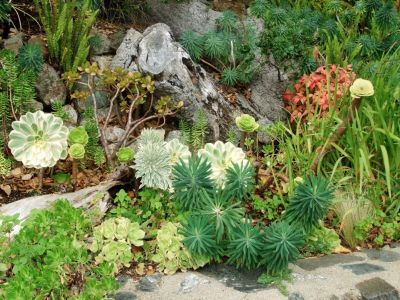Herbs for Xeriscaping
Many herbs thrive in hot, arid conditions and are great for xeriscaping. Consider some drought-hardy herbs when planning your xeriscape herb garden. These may include:
Bee balm Lavender Marjoram Yarrow Sweet alyssum Oregano Thyme Rosemary Russian sage Lamb’s ears
Herbs are plants for all seasons and situations. Herbs are a great asset in a landscape designed for low-water use. Most herbs bloom profusely throughout the summer season with very little water.
Vegetable Plants for Xeriscaping
Research heirloom vegetable plants. Learn what used to be grown before the advent of plumbing. There are many vegetables out there that will love your xeriscape climate. Contact your local agricultural extension agency and ask for lists of plants they suggest for your area. For vegetables that may not adapt as easily to drier conditions, take plastic containers with a few holes drilled in the bottom and bury them at the base of the plants just enough that the tops are still sticking out. Use these for watering. They will remain full for longer periods, reducing your need for continual watering. Check them occasionally to prevent your vegetables from drying out and fill them as needed. Consider growing plants that avoid the drought season. For instance, many vegetable plants have a fast growth cycle and produce crops well before the heat of summer arrives. Plants finished before drought conditions become severe include:
Onions Broccoli Cabbage Spinach Radish Beets Leaf lettuce
Many of these vegetables are such fast growers that they can be planted again in the fall. In the summer, grow drought-tolerant plants. Unbeknownst to many, there are actually a lot of vegetable plants that have excellent drought tolerance. Vegetables such as the following continue to produce even in dry weather:
Southern peas Okra Sweet potatoes Muskmelons
Combine vegetables and herbs. For instance:
Place tomatoes with basil, horehound, dill, parsley, or sage. Try planting peppers with sweet marjoram. Plant squash with borage. Turnips and thyme do well together. Cucumbers enjoy growing next to lemon balm.
You can also include other drought-tolerant or native plants in your vegetable-herb garden for additional interest. For example, native wildflowers such as purple coneflower, black-eyed Susan, butterfly weed, and verbena provide color in even the driest of weather. With careful planning, it is possible to have a thriving herb or vegetable garden in a xeriscape environment. There are numerous types of herbs and vegetables that can be successfully incorporated into these water-thrifty landscapes. Perhaps the best way to accomplish this is through the use of raised beds. These make watering easier and allow for looser soil, which enables the roots of plants to reach deep into the ground and better resist drought-like conditions.
